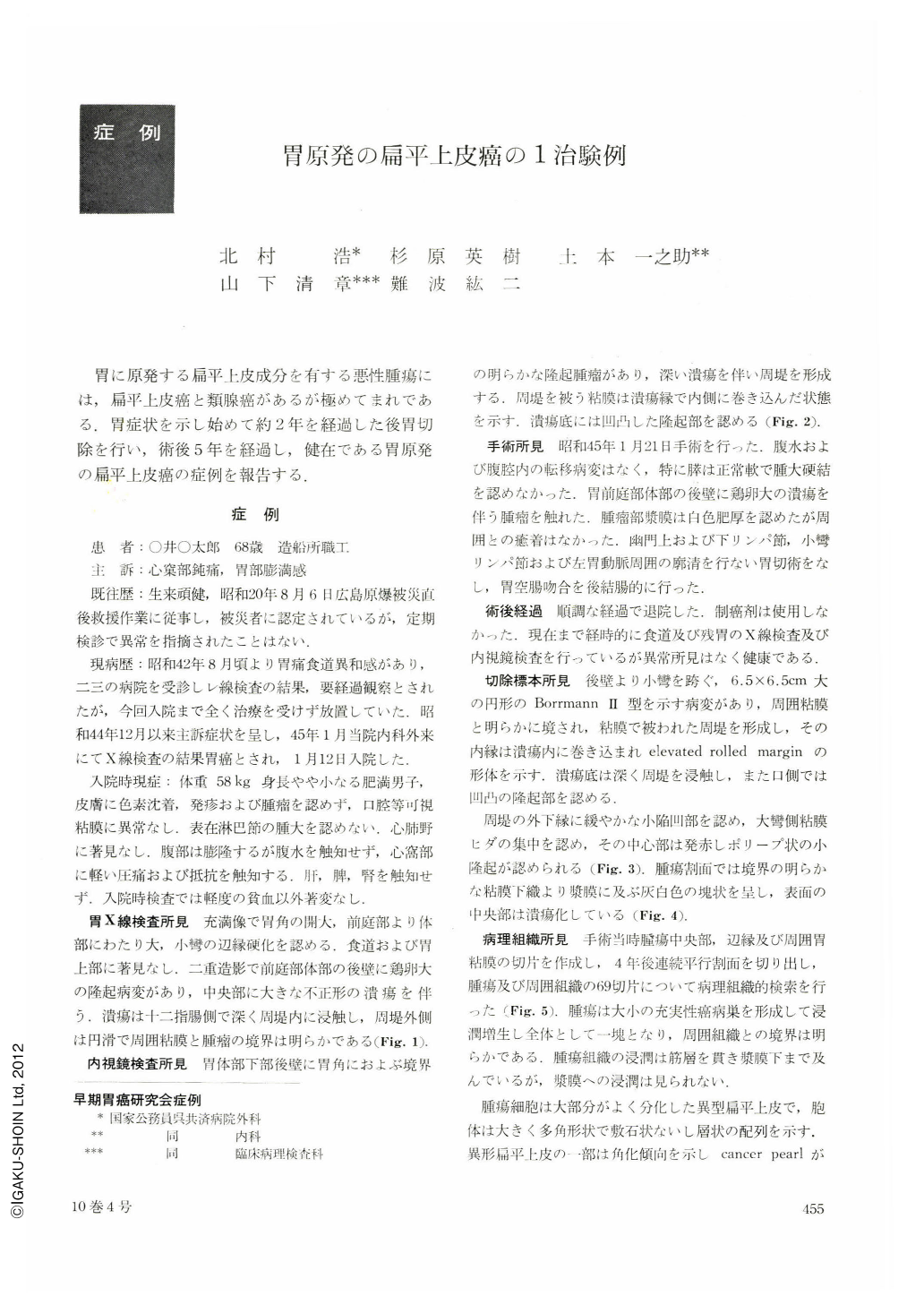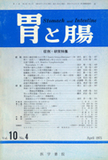Japanese
English
- 有料閲覧
- Abstract 文献概要
- 1ページ目 Look Inside
胃に原発する扁平上皮成分を有する悪性腫瘍には,扁平上皮癌と類腺癌があるが極めてまれである.胃症状を示し始めて約2年を経過した後胃切除を行い,術後5年を経過し,健在である胃原発の扁平上皮癌の症例を報告する.
The patient is a 69 years old male. He had been exposed to the atomic bomb in Hiroshima, but was previously in good health. Abnormality of the stomach was pointed out when he was examined by x-ray because of complaints of epigastric pain and esophageal foreign sensation in Aug. 1967. In Dec. 1969, he consulted our clinic complaining of epigastric dull pain and full sensation, and was admitted to the hospital with a diagnosis of gastric cancer.
Physical examination revealed epigastric tenderness and resistance, but otherwise no objective signs were found.
Double contrast roentgenogram revealed a well delineated Borrmann Ⅱ type cancer as is shown in Fig. 1. With the gastroscopic study, the tumor was seen to protrude from posterior wall and to have elevated and rolled margin, The base of the ulcer was rugged as shown in Fig. 2.
The patient underwent gastrectomy on Jan. 21th, 1970.
The resected stomach is shown in Fig. 3, 4 round tumor 6.5×6.5 cm. in size was situated in the posterior wall of the pyloric antrum and body, extending beyond the lesser curvature. There was a conspicuous ulcer in the center of the tumor, and the margin of the tumor was well demarcated. The neoplasm was macroscopically Borrmann Ⅱ type gastric cancer. A small area with convergence of mucosal folds was found just at the outside of the inferior margin of the tumor (Fig. 3, 4). Histologic sections of serial 69 blocks were cutout from the stomach including the tumor, and resulting H & E stained slides were investigated microscopically (Fig. 5).
The tumor was composed of well differentiated squamous cell carcinoma in almost all the parts. Keratinization of cancer cells, epithelial pearl formation and intercellular bridges were encountered frequently as shown in Fig. 6~8, No component of adenocarcinoma was found within the tumor, nor was squamous cell metaplasia of the surrounding gastric mucosa found.
The reddened mucosal area in the inferior margin of the tumor was found microscopically to be a minute superficial adenocarcinoma 4×2×1.5 mm in size. No connection with the main squamous cell carcinoma was found as the result of analysis of the serial sections (Fig. 9). Therefore, it was concluded that the adenocarcinoma was an independent mucosal carcinoma.
Some authors believe speculatively in squamous cell metaplasia of basal cells and of adenocarcinoma cells as the origin of primary gastric squamous cancer cells.
A roentgenogram taken 2 years before the operation is illustrated here. Abnormal findings to the site of this tumor can already be pointed out, and they are thought to represent a new concept on the early finding of this type of tumor.
The patient's course for 5 years after the operation has been unventful and he is good at present in Jan. 1975.
As for the reported cases of gastric squamous cell carcinoma in Japan, adenoacanthoma was seen in 17 cases and pure squamous cell carcinoma in only several cases.

Copyright © 1975, Igaku-Shoin Ltd. All rights reserved.


